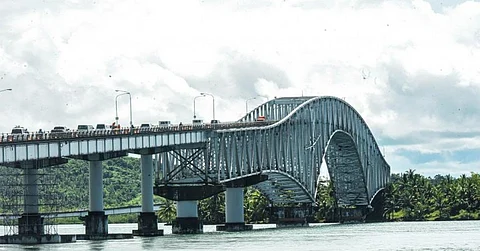
- NEWS
- the EDIT
- COMMENTARY
- BUSINESS
- LIFE
- SHOW
- ACTION
- GLOBAL GOALS
- SNAPS
- DYARYO TIRADA
- MORE

TACLOBAN CITY — The plan to build a second bridge linking Samar and Leyte — running parallel to the iconic San Juanico Bridge — has won the endorsement of the Tacloban City Development Council during its meeting on Friday.
Dubbed the Second San Juanico Bridge (SSJB), the project will be largely financed through a Japan International Cooperation Agency (JICA) loan, which will cover 86 percent of the cost. The national government will shoulder the remaining 14 percent.
The proposed bridge will connect Barangay San Isidro in Tacloban City to Barangay San Juan in Sta. Rita, Samar, offering motorists an alternate route to the aging San Juanico Bridge.
Valued at P19.75 billion, the project will feature a two-lane steel arch design with truss elements for the main span and AASHTO girder sections supported by multiple columns. It is considered a high-priority infrastructure initiative under the Marcos administration.
Environmental and social impact
JICA has classified the SSJB as a “Category B” project — meaning it may have significant but manageable environmental and social impacts.
According to JICA, the site is not in a sensitive area, nor does the project have characteristics that would cause major environmental damage.
Feasibility and planning
JICA recently wrapped up its fact-finding mission with a high-level meeting at the Department of Public Works and Highways (DPWH) on 25 July.
The final feasibility study is expected by September.
DPWH says the new bridge will allow for the full rehabilitation of the existing San Juanico Bridge, which is currently undergoing emergency repairs.
Once the updated technical report and economic analysis are in, DPWH will coordinate with the Department of Economy, Planning, and Development for Investment Coordination Committee review.
The agency’s timeline calls for:
September 2025 — Environmental Compliance Certificate
November 2025 — Economic Development Council approval
January 2026 — Loan signing with JICA.
Construction timeline and features
The project will undergo a 15-month detailed engineering design phase, with civil works slated to start in 2028 and run for about 32 months.
Aside from the bridge and approach roads, the project will include operations and maintenance facilities.
According to DPWH, the design will integrate advanced Japanese technologies, such as:
Paint life extension steel for durability and low maintenance
Composite slab technology to shorten construction time
Seismic isolation bearings for earthquake resilience.
